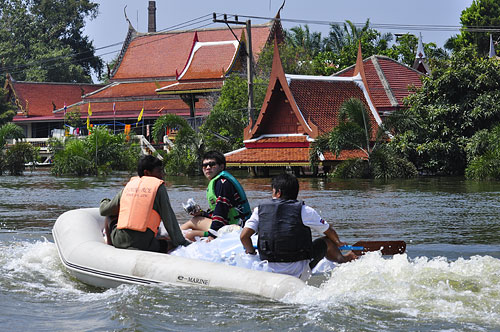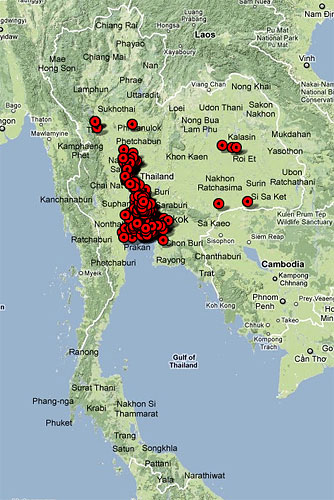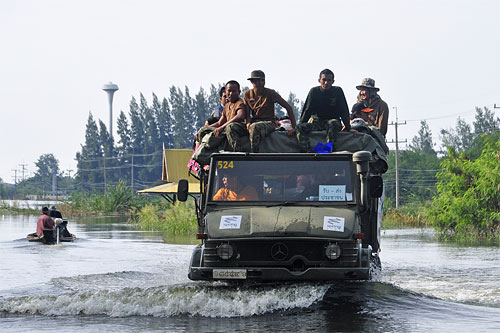In the central provinces north of Bangkok, the floods have already caused major disruption to the lives and businesses of millions. Since our last report two weeks ago, the death toll has now passed 350, and nearly one-third of the country is now said to be underwater. As well as huge areas of farmland, a significant proportion of Thailand's factories have found themselves inundated by waters that have reached or even surpassed three meters in depth in some areas. Reports from the country's media suggest that 1,300 factories staffed by some 400,000 workers have now been affected, including seven major industrial parks that are home to companies including Canon, Nikon, and Sony.
Over the weekend, Thailand's Prime Minister Yingluck Shinawatra cautioned that it may be take another four to six weeks before floodwaters retreat to manageable levels. The country is said to be preparing a ฿25 billion (US$810 million) recovery package that is intended to bring most of the factories back online within 45 days of the floodwaters receding, but with year's end fast approaching, it looks inevitable that some factories will remain shuttered through the peak holiday season.

|
Widespread flooding in Thailand has closed roads and inundated property in the country's central provinces.
Photo by Suriya Thonawik, provided with public domain license by Fotopedia.com. |
At the time of our earlier report, the floods had breached defenses around two main industrial parks: Saha Rattana Nakorn Industrial Estate and Rojana Industrial Park, both located in Ayutthaya Province. The latter is home to Nikon (Thailand) Co. Ltd., which according to Japan's Yomiuri Shimbun newspaper, is responsible for production of the company's low- to mid-range SLR cameras. As of Yomiuri's report a week ago, Nikon's factory was still listed as without prospect of recovery, which is worrying given Yomiuri's assertion that low- to mid-range models make up some 90% of the company's SLR production. The Rojana Industrial Park also houses Canon Ayutthaya (Thailand) Ltd., responsible for producing printed circuit boards used in the company's inkjet printers, as well as Sanyo Semiconductor (Thailand) Co. Ltd., which produces CCDs image sensors and LSI chips.
In the days following, five other industrial parks fell victim to the floodwaters in rapid succession. On October 13th, efforts to repair a damaged dyke at Ayutthaya's Hi-Tech Industrial Estate were abandoned. One notable plant located at Hi-Tech is Sony Technology (Thailand) Co. Ltd., which manufactures p
roducts including Alpha SLR and NEX compact system camera bodies, as well as interchangeable lenses. Shortly thereafter, Sony Marketing (Japan) Inc. announced that it was postponing Japanese-market availability of products including the NEX-C3, NEX-5N, NEX-7, and Alpha SLT-A65, and Sony Hong Kong followed suit with a delay for the NEX-7 in that market. Note, though, that the company has yet to announce any such delay in the US market. (A possible reason for this relates to the time factors involved in shipping by sea. Countries closer to the factory were likely scheduled to receive stock from later in the production run, where those further from the source may already have stock enroute from earlier production.) Other occupants of the Hi-Tech Estate include Canon Hi-Tech (Thailand) Ltd. and Canon Engineering (Thailand) Ltd. The former is responsible for inkjet printer manufacture, while the latter makes unspecified injection-molded plastic parts.
Most recently, a flood barrier failed at the Bangkadi Industrial Park in Pathumthani, submerging 47 factories in waters up to four meters in depth. Among the facilities located in Bangkadi is Sony Device Technology Thailand, which produces CMOS and CCD sensors including those intended for use in interchangeable-lens models, as well as unspecified LSI chips.

|
In the map of Thailand above, locations described as "severely affected" and in need of urgent help are indicated with red markers, giving an idea of the huge scope of the flooding.
Map provided by Google Crisis Response, overlaid markers by ThaiFlood.com. |
Even for companies whose production facilities are located outside the flood-hit areas, knock-on effects are possible, as parts suppliers may well be affected. On October 14th and 15th, the Bang Pa-in Industrial Estate and Factory Land Wang Noi were in turn surrendered to the advancing floodwaters, followed two days later in Pathumthani by the Nava Nakorn Industrial Promotion Zone. Nava Nakorn is home to Nidec Copal (Thailand) Co., Ltd., whose products include digital camera shutter mechanisms and lens assemblies. Also located in the zone is tripod manufacturer Slik (Thailand) Co., Ltd.
The Saha Rattana Nakorn Industrial Estate, meanwhile, is home to EPE (Thailand) Co., Ltd., which supplies parts for use in digital cameras and camera phones. At the Hi-Tech Industrial Estate, IM Electronics (Thailand) Co. Ltd. produces flexible printed circuit boards that, again, find t
heir way into cameras and cell phones. Kawabe Technoplas (Thailand) Co. Ltd., whose factory is in the Nava Nakorn Industrial Promotion Zone, supplies molded plastic parts such as SLR hand grips and bodies for both flash strobes and mobile phones. Of course, these are just the companies we're aware of with clear links to the imaging industry. Doubtless, there are other, less obvious companies playing equally important parts in the supply chain that have likewise found themselves affected.
Our thoughts and prayers are with the people of Thailand at this difficult time, as well as with neighboring Southeast Asian countries also hard-hit by flooding over recent weeks. Readers wishing to make donations, find out how they can help, or get more information related to the situation can find details on Google's Crisis Response website.

|
Military vehicles can handle fairly deep water, but even they'd be of no use in the worst-hit areas.
Photo by Suriya Thonawik, provided with public domain license by Fotopedia.com. |